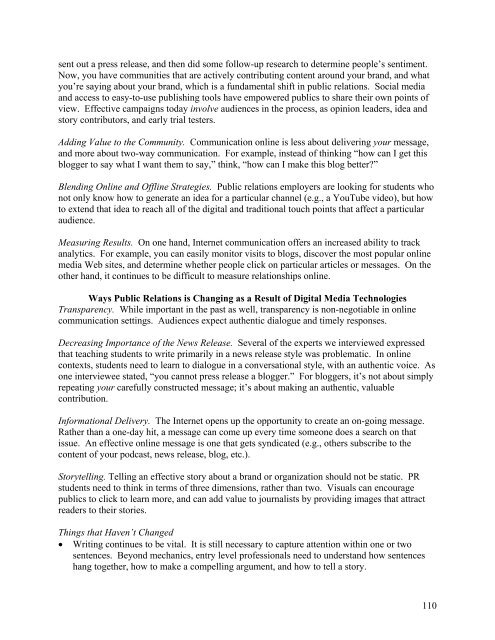2008 PROCEEDINGS - Public Relations Society of America
2008 PROCEEDINGS - Public Relations Society of America
2008 PROCEEDINGS - Public Relations Society of America
You also want an ePaper? Increase the reach of your titles
YUMPU automatically turns print PDFs into web optimized ePapers that Google loves.
sent out a press release, and then did some follow-up research to determine people’s sentiment.<br />
Now, you have communities that are actively contributing content around your brand, and what<br />
you’re saying about your brand, which is a fundamental shift in public relations. Social media<br />
and access to easy-to-use publishing tools have empowered publics to share their own points <strong>of</strong><br />
view. Effective campaigns today involve audiences in the process, as opinion leaders, idea and<br />
story contributors, and early trial testers.<br />
Adding Value to the Community. Communication online is less about delivering your message,<br />
and more about two-way communication. For example, instead <strong>of</strong> thinking “how can I get this<br />
blogger to say what I want them to say,” think, “how can I make this blog better?”<br />
Blending Online and Offline Strategies. <strong>Public</strong> relations employers are looking for students who<br />
not only know how to generate an idea for a particular channel (e.g., a YouTube video), but how<br />
to extend that idea to reach all <strong>of</strong> the digital and traditional touch points that affect a particular<br />
audience.<br />
Measuring Results. On one hand, Internet communication <strong>of</strong>fers an increased ability to track<br />
analytics. For example, you can easily monitor visits to blogs, discover the most popular online<br />
media Web sites, and determine whether people click on particular articles or messages. On the<br />
other hand, it continues to be difficult to measure relationships online.<br />
Ways <strong>Public</strong> <strong>Relations</strong> is Changing as a Result <strong>of</strong> Digital Media Technologies<br />
Transparency. While important in the past as well, transparency is non-negotiable in online<br />
communication settings. Audiences expect authentic dialogue and timely responses.<br />
Decreasing Importance <strong>of</strong> the News Release. Several <strong>of</strong> the experts we interviewed expressed<br />
that teaching students to write primarily in a news release style was problematic. In online<br />
contexts, students need to learn to dialogue in a conversational style, with an authentic voice. As<br />
one interviewee stated, “you cannot press release a blogger.” For bloggers, it’s not about simply<br />
repeating your carefully constructed message; it’s about making an authentic, valuable<br />
contribution.<br />
Informational Delivery. The Internet opens up the opportunity to create an on-going message.<br />
Rather than a one-day hit, a message can come up every time someone does a search on that<br />
issue. An effective online message is one that gets syndicated (e.g., others subscribe to the<br />
content <strong>of</strong> your podcast, news release, blog, etc.).<br />
Storytelling. Telling an effective story about a brand or organization should not be static. PR<br />
students need to think in terms <strong>of</strong> three dimensions, rather than two. Visuals can encourage<br />
publics to click to learn more, and can add value to journalists by providing images that attract<br />
readers to their stories.<br />
Things that Haven’t Changed<br />
• Writing continues to be vital. It is still necessary to capture attention within one or two<br />
sentences. Beyond mechanics, entry level pr<strong>of</strong>essionals need to understand how sentences<br />
hang together, how to make a compelling argument, and how to tell a story.<br />
110
















